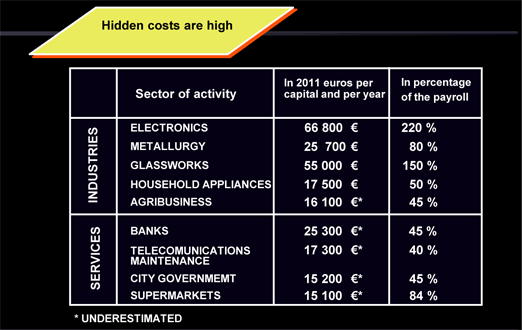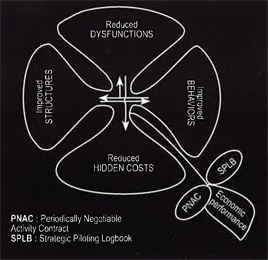Results of research – intervention
in enterprises
|
Dysfunctions, regleted valuable
potential resources.
The interaction of structures and behaviors within a firm creates 6 families
of dysfunctions.These 6 categories constitute both explanatory variables
of the company operation and control levers on the dysfunctions detected in the diagnosis. |
|
-
THIS SIX FAMILIES CONSTITUTE
-
Explicative variables of functioning
-
Axes of solutions for the identified dysfonctions
|
|
| |
- Hidden costs are high - Average hidden costs
|
| |
| Example of hidden costs extracted from 2000 cases of companies and organizations (72 sectors) |
|

The results are underestimated, considering the allotted time in the study, and inter-compagnies comparisons are not significant
Hidden costs : these are the costs left out of the company's
information system (budgets, financial accounting, cost accounting
and other indicators), as opposed to visible costs which are
duly taken into account (wage costs, raw materials ...).Hidden costs
are thus neither quantified nor controlled. They, however, affect
the firm's performance, but, since they are hidden, they are not taken
into account when decisions are taken by the management. |
|
Qualitative, quantitative and financial results of socio-economic
interventions
Example: measured performance of a small team in a large scale pilot case
|
| Indicators |
Qualitative performance |
Quantitative performance |
Financial results in euros (per capita and per year) |
| Absenteeism |
- Increased motivation on the job
- Flexible working hours |
- A 3% reduction in absenteeism due to sick leaves |
800 € |
| Industrial injuries and occupational diseases |
- Increased sensitization to occupational hazards
- Doing away with undue haste |
|
|
| Personnal turnover |
- A lesser risk of turnover amongst newly hired personnel
- facilitated training |
|
|
|
Non quality |
- Fewer defects
- Improved regulation of defects
- Waste reduction |
- Reject percentage cut by half |
3 200 €
|
| Direct productivity |
- Increased pace
- Shorter delay |
- + 16.2% over the period
-Delivery terms cut down by 2 and a half weeks |
7 700 €
|
| Total (per capita and per year) |
11
700 € |
|
| |
- Sizeable financial results subsequently obtained:
As regards the evaluated piloting
actions as a whole: from 20 000 € to 70 000 € per capita and per year of hidden costs converted in reduced charges, increased production
(i.e. a higher profitability ratio) and self-financed intangible investment
increase.
A higher degree of satisfaction is thus reached among people external
to the firm (clients, suppliers and other stakeholders) and its staff (from the CEO to employees and
workers).
How can such results be obtained?
The major questions ISEOR research-interventions are trying to answer are:
- How can we reach a higher and sustainable level of socio-economic performance?
- How can we implant a new mode of management well adapted to
the characteristics of an enterprise and its strategy?
- How can we succeed in grafting new ideas, new technologies, new types
of organization, new products, new client relationship new skills, new modes of operation without
facing rejection, blocking, disruption, while helping the firm transform
itself thoroughly (metamorphosis)?
- The enterprise or organization following a socio-economic intervention

Piloting actions aimed at implanting
the socio-economic management system arrived at within small and medium sized
firms as well as in larger enterprises representing a wide
range of organizations employing between 4 and 30,000 people in the private
and public sectors, thriving on experiencing financial difficulties.
The adaptability of the socio-economic method made it easy to
apply in over 2,000 enterprises and organizations within a wide range of business
activities (72) throughout the world (46 countries over the four continents).
|
| |
Follow up : Socio-Economic Intervention
Back to menu ISEOR activities |
| |

